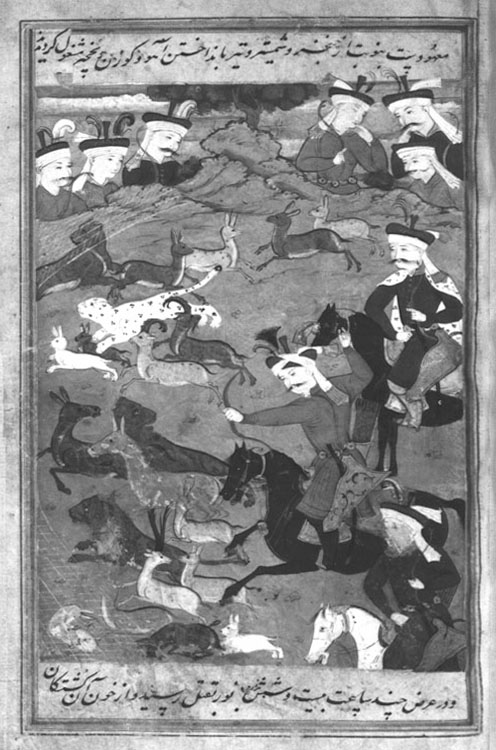Date of this event: 917/1511.
Following the Khorasan campaign which ended in 916/1510, Esmāʿil remained the winter of 1510-11 in Herat (see f. 199), and then returned to Qom in 917/1511. Having been involved for a considerable time with battle and the subjugation of the Uzbeks, Esmāʿil longed to go hunting. He issued orders far and wide that all the animals in the area should be driven towards the ḵandaq (moat) of the fortress of Qom (see f.115v, where a similar order was issued, and a similar hunt portrayed). The text further elaborates that in a few short hours, using in turn a dagger, sword, and bow, Esmāʿil and his companions killed twenty-six different types of animals.
Shah Esmāʿil, astride a dark charger, is depicted in the right foreground having just let an arrow fly at a fleeting prey. He is accompanied by two qezelbāš, one on either side and slightly to his rear, who observe the shah’s charge with bow in hand. The one to the shah’s right, with leopard skin cape, appears to be a local governor, perhaps of Qom. As usual, the ground slopes upward to a rocky ridge near the top of the painting, from which a small tree emerges on the central vertical axis. The heads of six additional Safavids, three on each side, peer intently over the ridge line at the hunt below. A net has been stretched across the left side from the top of the hill to the bottom, into which the animals have been driven. Most flee away from their pursuers directly toward the net, but some having already encountered the net, have reversed their direction returning back toward whence they came. Altogether twenty animals are depicted including ibex, deer, goats, rabbits, lions, onager, and a leopard or cheetah -- all of which are rather diminutive in size compared to the shah and his entourage.
Painting: 16.7 x 12.2 cm. One line of text above and below the painting. Frame encloses painting and text. The face of the ǧāzi in the lower right has been damaged by abrasion. No other signs of significant damage. Unsigned.
Painting references:
Unpublished.
Robert Eng
Last updated: November 24, 2010
